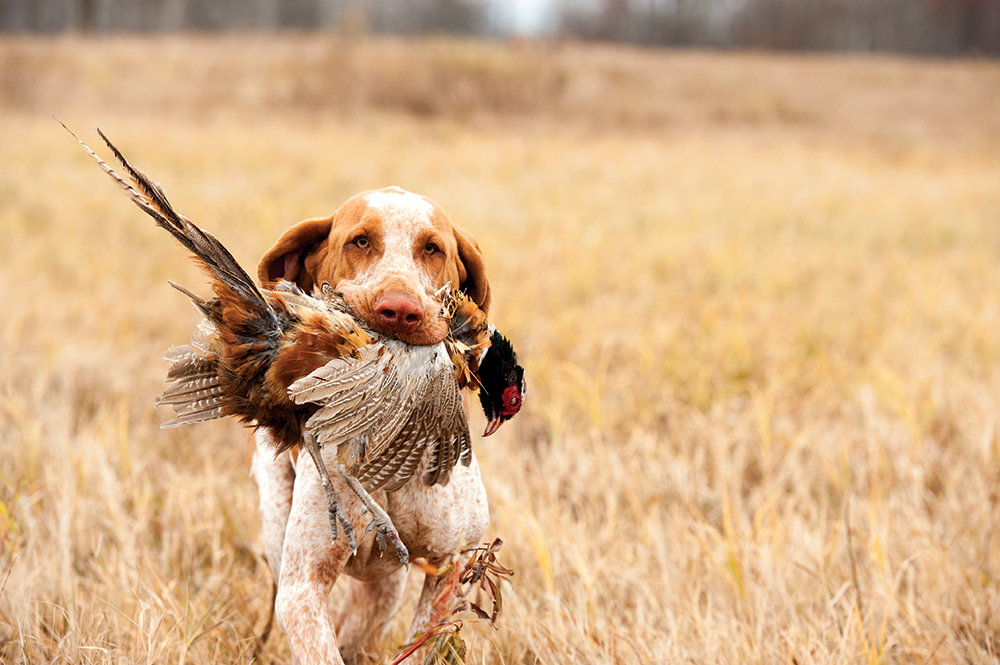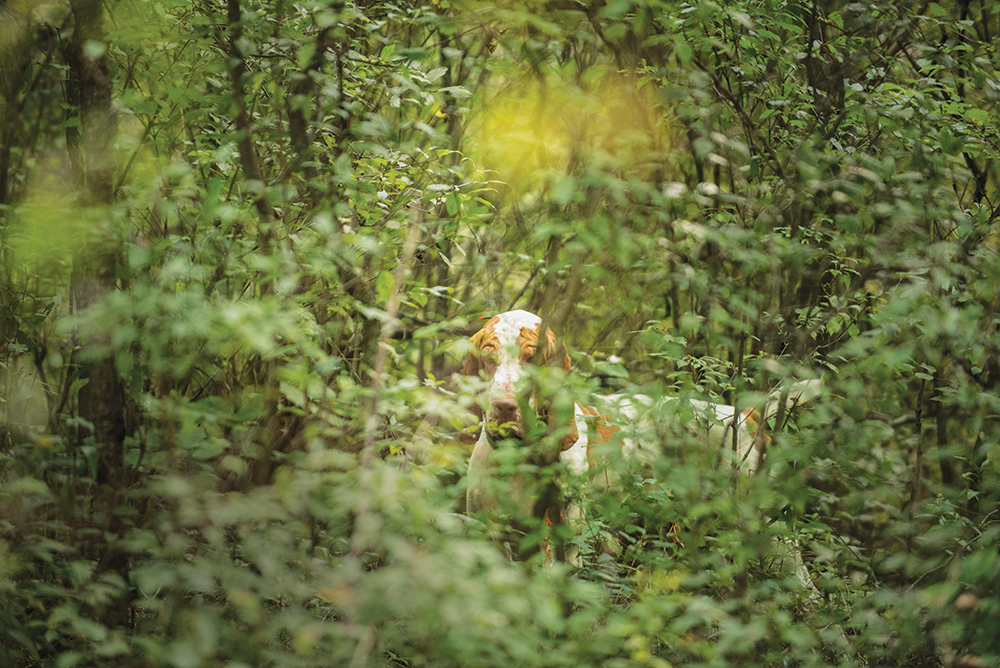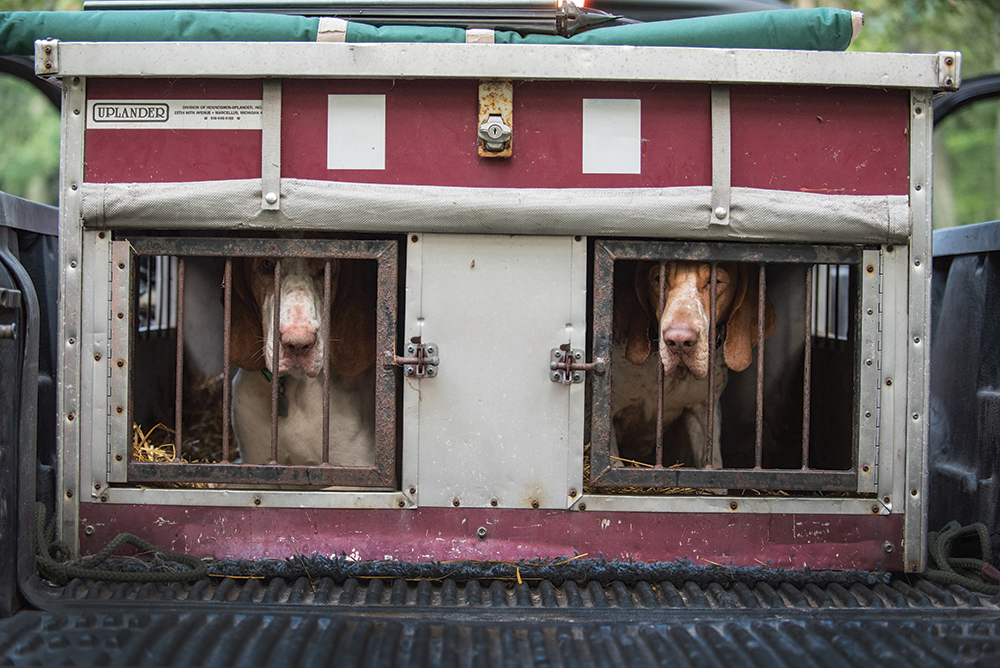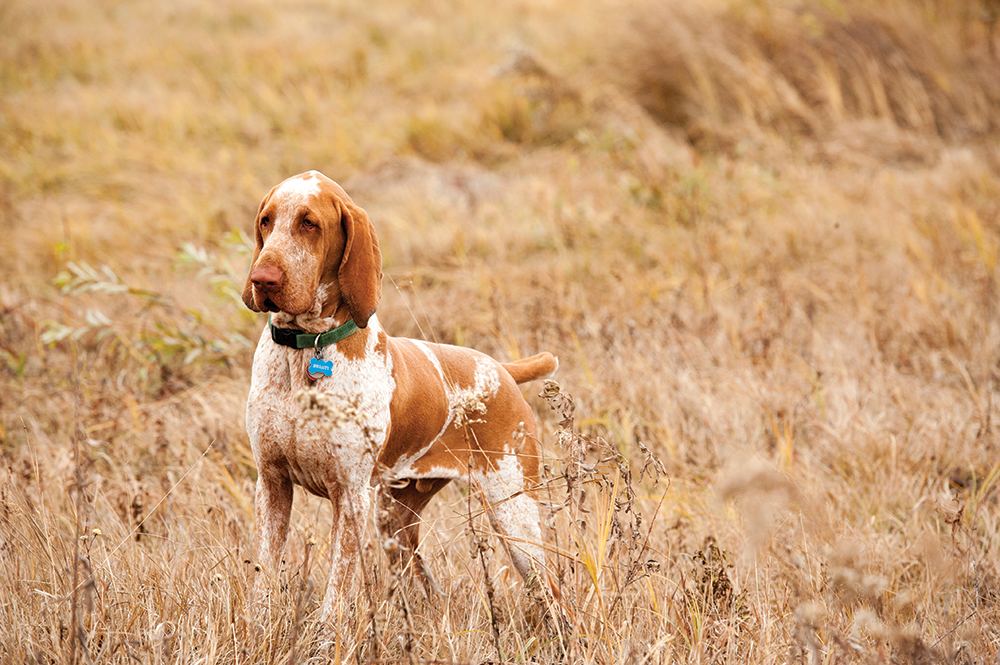Bred for Birds and Terrain

The most intriguing description of a Bracco Italiano’s hunting style pairs the dog’s mind with its movement. “The Bracco must use the trot, gallop, and nose in specific ways suitable to the terrain, wind, field conditions, and birds,” says Ericka Dennis, owner of the first Bracco Italiano to earn a Versatile Champion title. “Primarily the trot is long, fast, and brisk. How it uses the trot is what we call the thinking part of the breed’s working standard. For instance, if the terrain is relatively flat and even, it should trot most of the time unless going back over parts already searched. If the terrain is rocky, we would not expect as much trot. The benefit of the trot, we think, is the ability to adapt to the terrain, to think about the hunt, and to hunt for longer periods of time. A Bracco should approach a bird in a slow, methodical way, closing in on scent, as opposed to a faster-paced dog, which would do a short stop.”
All pointing breeds vary their speed and gait. Many slam on point with the determination of a batter hitting third base to break a tie in the ninth. Many switch into a creeping stealth mode when they move deep into a scent cone. But when Bracco owners talk about the breed, they emphasize that the trot is part of the breed’s working standard, a very detailed and specific way the Bracco should hunt upland game.
Similarly, the Bracco’s scenting style is part of the working standard. “The long ears and the folds around the head draw scent into the nose, making the Bracco a superior scenting dog,” Ericka explains. “Part of the working standard is the proper way the Bracco should hold its head while trotting, the nose in the air. This has to do with the construction of the head, divergent cranial axes. The nose is parallel to the ground when the head is held high. People call it ‘air scenting,’ but really all dogs do that. As for the ground scenting, like bloodhounds, the Bracco can do that very well, however, the working standard does not allow for the head to be down like that. Therefore, the Italians say no, the Bracco does not track, should not track. Doesn’t mean they can’t!”

Ericka, who primarily hunts chukar and pheasant in California, currently owns four Bracchi, ages ranging from 6 months to 12 years. She’s had 7 over the years, which may not sound like a lot of dogs, but given how rare the Bracchi are, it is notable. Worldwide, there are only about 4,000 Bracchi (mostly in Italy), whereas there are about 10,000 German shorthaired pointers bred each year in the US alone.
Knowing nothing about hunting, Ericka got her first Bracco, Rico, for the show ring. He won rare breed competitions throughout the Southwest, but didn’t get a shot at his true destiny until she saw him point a pigeon at the first national Bracco Italiano breed gathering in 2003. That was all it took to get Ericka into hunting.
Fast forward to 2011, and Ericka’s Regina passed the North American Versatile Hunting Dog Association’s (NAVHDA) Invitational Test, the title “VC” then added to Regina’s pedigree. The NAVHDA Invitational is open only to dogs who have had top achievement in their training and testing. Judged in extensive field and water work, Invitational dogs and their handlers must demonstrate advanced skills in a range of hunting situations, from an hour-long field hunt in a brace to a 100-yard blind retrieve across open water. The dogs are judged in 14 categories, including day-long evaluation of nose, desire, cooperation, and obedience. Historically, only 50 percent of the dogs running, or fewer, pass each year. It is nerve-wracking, thrilling, and enormously challenging.

Ericka describes her experience, “Wow, the VC title. I can’t tell you how much work that was and how very proud I am of Regina. She was not nervous, but I was almost physically sick. The highlight for me was the end, when the scores were announced. I think that was the first time I took a breath all day. Most people watching were curious about the breed, and I got a lot of questions and some surprised looks. They were impressed. Some people still had a preconceived notion that the Bracco is slow and not a good hunter. My goal with the Utility Test and the Invitational was to prove that this dog was a good hunter and not a junk dog. I hope I helped to quash some of the prejudices.”
On the other end of the Bracco Italiano ownership spectrum are Alexandra Cianciosi and her partner Chad Walz, who live in Vermont and own Stella, their first Bracco. Alex had a beagle and wanted another beagle or a hound. Chad wanted an upland gun dog. They both wanted a dog that would be an excellent family dog. Chad carefully researched breeds and found the Bracco to be the perfect solution. Alex got the hound look; Chad got the bird dog. When asked about Stella’s hunting style, Chad jumps right to the trot and working standard Ericka described.
“Even though she started hunting at 8 months old, I definitely saw some of the traits Bracchi are known for,” Chad says. “That trotting gait is amazing. After a few minutes of going full tilt, Stella would settle into that elongated trot and just cruise, and for long periods of time, too. It’s a great pace to keep up with—not to mention incredible to watch—and since Stella quartered naturally, there was very little work needed to get her to stay within gun range.”

Chad continues by describing Stella’s scenting. “I have been thoroughly impressed with her nose. Stella spends most of her time air scenting, but owing to her ancient hound lineage, she does spend some time with her nose on the ground. If I remember right, William Harnden Foster wrote in New England Grouse Shooting that a good grouse dog spends time with its nose on the ground, and I am happy that Stella does. While admittedly I am a relative newcomer to upland bird hunting, to me it’s simple logic. I know grouse like to run, and having a dog that will work the scent on the ground as well as in the air is an added bonus.”
Joining the Spinone Italiano (the Spinone and the Bracco are the only two gun dogs developed in Italy), the Bracco Italiano traces that ancient lineage back to the 4th and 5th Centuries B.C. According to the Bracco Italiano Club of America (BICA), during the Renaissance the breed was valued by both the Medici and Gonzaga families, and often given as a gift from the Italian government to VIPs in other countries. Before serving as a pointing and retrieving gun dog, Bracchi were used to drive game into nets, then to flush quarry for falconers.
The Bracco Italiano coat is short and dense, with variations of markings acceptable to breed standards. It is believed that the orange-and-white variety originated in the Piedmont region of Italy, and the roan-and-brown variations came from Lombardy. This is a fairly large breed, weighing in the 55- to 88-pounds range. Bracchi are heavier boned than many pointing breeds, and like Spinoni have large feet suited to mountainous terrain. They are powerful and surprisingly quick.

Describing the Bracco Italiano as houndy is like saying a Ferrari is a sports car. True statement, but it doesn’t come close to saying it all. In profile, that magnificent Bracco head features a Roman nose and an outstanding set of jowls. From the front, its pendulous ears, large eyes, and furrowed brow strike an expression that is both noble and droll at the same time.
Ericka, Alex, and Chad all describe the Bracco temperament as people-oriented, loveable, and occasionally stubborn. Stella often goes to work with Alex at Covey & Nye, the fine sporting retailer in Manchester, Vermont. At other times, Stella accompanies Chad to Orvis, where he works as a sales planner. “I have never seen a dog that connects with people the way Stella does, and she picks up training so fast. She’s more than just a sporting breed,” Alex says. “Stella is gregarious. She is happiest when people are together and pay attention to her and to each other. She thrives on how people interact.”
Ericka agrees. “Generally, they are great family dogs, love to be around their people, and will cuddle when allowed, as much as possible. They follow me around the house and yard everywhere I go.”

For hunters interested in owning a Bracco Italiano, the BICA and NAVHDA are the best sources for breed and breeder information. Prospective owners should see the sire and dam in person, and interview the breeder for proof of health and hunt testing.
The Bracchi tend to mature slowly and be quite biddable but a little soft. “They can be stubborn during training. In other words, if you carry out the training in a firm but gentle manner, emphasizing the task through repetition, they will do whatever you ask of them, and are very trainable in that sense. Once you put too much pressure on them, they will cower or totally shut down and not do anything you ask,” Ericka says.
Stella is the first bird dog Chad has trained, and his gradual approach has served that biddable but stubborn blend well. “I was probably softer on training than many people are. I started by exposing her to pigeons at an early age. Throughout the summer, we did some yard- and fieldwork with wild pigeons and wings from previous seasons, but by no means was I religious about it,” Chad explains. “Given that, I have had her find and point birds in situations where I genuinely wasn’t expecting them.”
Working in a medium to close range, the Bracco Italiano is not a hard-charging gun dog, but it is known for its tenacity. Chad says: “I frequently hear of German shorthairs that will plow through everything, or the pudelpointer that doesn’t quit, but I have found the same to be true for my Bracco. It might not be with the reckless abandon of those breeds, but she will plow through anything, and look stylish doing it. The woods here in Vermont tend to be thick, and as a result, most of my friends favor smaller dogs. Stella is just shy of 60 pounds, which is between 20 and 30 pounds heavier than most of my friends’ dogs. Honestly, with her attitude, and her long and strong legs, you wouldn’t see any difference in her ability to get through the thick stuff.”
Thoroughness goes with that tenacity. “If there is a large field, they must search every part of it. Think of a field plow: Go all the way to the right, turn; go all the way to the left, turn. If I am walking in the middle of the field, I will not have to walk very fast,” Ericka says.
Regina and Stella, champion and newbie. Both represent their unique breed well, possessing the working standard, appearance, and personality that capture their owners’ hearts. One of Ericka’s favorite stories sums it up well.
“My dogs and I participate in junior pheasant hunts here in Southern California. Some of the kids are good shots, and some have never picked up a gun much before that day. I remember one particular hunt, and one boy who was a little unsteady with his shot. He was probably around 9 or 10 years old. The pheasant flushed and flew straight away. He got a piece of it, but not much. The bird faltered about 200 yards out. The boy was so disappointed, because he figured he would never get his pheasant. I said to him: ‘No problem, my Regina will get it for you.’ I sent her on the mark. Several minutes later, she came straight back with his bird. Totally rewarding. That made his day! And mine.”
























